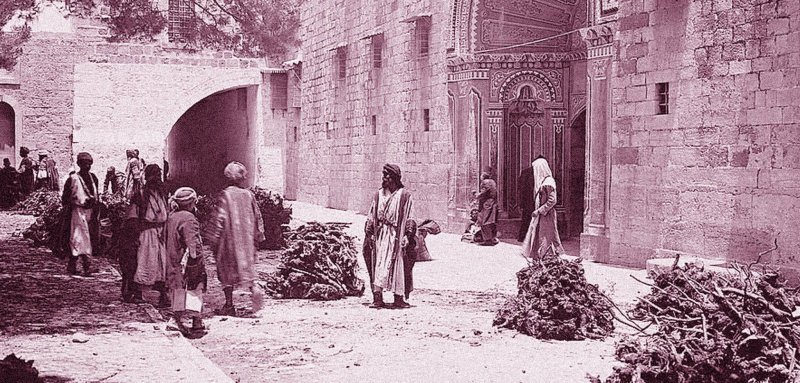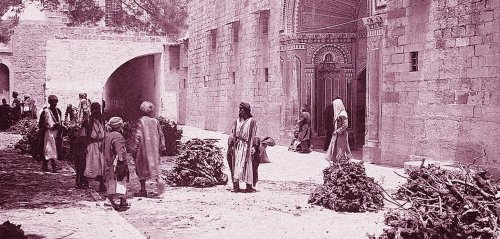Aside from Arabs, the Palestinian communities in Jerusalem consist of a number of diverse ethnic groups and minorities that have migrated to the city for various reasons over the years. However, these groups, which include Africans, Kurds, Turks, and Armenians, were able to write their own unique history, and in turn, form an interesting and unparalleled identity within the city.
“It is of little doubt that the existence of Armenians in Jerusalem constitutes an integral part of its narrative throughout the ages. Yet despite them being a minority expressing their own independent cultural identity, they were able to mirror the aspect of the city rich in art and culture. What distinguishes the Armenian community from other Christian denominations and remaining minorities in Jerusalem is that its history hasn’t vanished during any juncture since Byzantine times. Their existence was never tied to any occupation and did not end with its demise.
In spite of this strong connection with the history of the city, thousands of years in the city of Jerusalem was not sufficient enough to make Armenians forget their root heritage and original nationality. It sometimes even outweighed their Palestinian identity. At the same time, they endured suffering, forced displacement, and slaughter similar to the Palestinian people. They also played a major role in moulding the city’s identity and shaping its culture and art, according to the paper by Bayan Nouwayhed al-Hout, “Armenian Pages in The History of Jerusalem”.
“Jordanian military commander Abdullah al-Tal states in his journal that Armenians saw themselves as Arabs during the 1948 war in Palestine, where they “drank from the same cup as Palestinian” did, until they lost at least 8 martyrs in Jerusalem and Jaffa.”
A Diverse Ethnic History in a Historic City
There are no official statistics in relation to the number of Armenians in the city of Jerusalem, however, Armenian historian Ibrahim Banalian tells Raseef22 that, according to his estimate, their numbers currently range between 1000 to 2000 individuals, despite surpassing 25,000 people before the 1948 Palestinian exodus or ‘Nakba’.
Banalian says, “The introduction of Armenian existence in Jerusalem reaches back more than 1,600 years, the same time Armenians embraced Christianity, after which they traveled to the city for pilgrimage and some settled there to be closer to the holy city. In addition to that, the presence of some Armenians is a direct result of their forced exodus following the massacre carried out by the Ottoman government against them.”
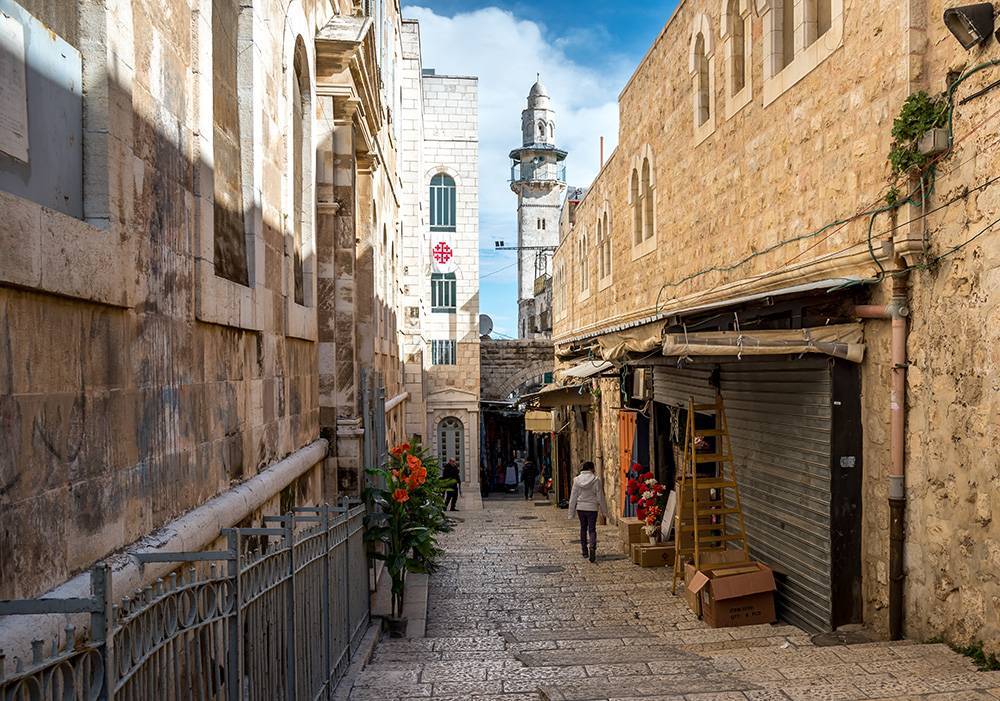
Despite playing an integral role in the establishment of events in Jerusalem’s history, Armenians living there were able to fully maintain their traditions, customs, and traits. They even have their own title for local Armenians who have lived in the city for hundreds of years, the ‘Kagahakatsi’.
Banalian sees that while Armenians in Jerusalem identify themselves as Palestinians, their primary allegiance is to Armenia; something that proves their collective association to the Armenian identity. The historian believes that Armenians are spiritually connected to the city of Jerusalem, despite the consecutive migrations and social and political events over past years that have led to their distancing from the holy city.
“The Armenian Quarter, located in the southwestern corner of Jerusalem’s Old City and occupying a fifth of the space within the Old City’s walls, boasts an old-school Armenian style with an Eastern touch.”
The Armenian Quarter, located in the southwestern corner of Jerusalem’s Old City and occupying a fifth of the space within the Old City’s walls, boasts an old-school Armenian style with an Eastern touch. Once one enters the heart of the neighborhood and stands before the ‘Saint Jacobs Armenian Cathedral’, where visitors are welcomed in three languages (Armenian, Latin, and Arabic), he finds himself seemingly transported hundreds of years back.
The cathedral is surrounded by several churches, most notably the ‘Cathedral of Saint James’, as well as gardens, museums, schools, houses, community centers, and libraries. It is said the Armenian Quarter holds the second largest Armenian library for manuscripts in the world.
Perhaps dialect is one of the most prominent aspects outlining their unique culture and national identity, since Armenians speak in an accent quite distinct from other Christians in Jerusalem. According to a study published by Harvard University, the key components of Armenian dialect in Jerusalem come from major Arab influence on the most part, as well as influence from the Armenian and Turkish languages. Nevertheless, it was cause for listeners’ admiration amongst Palestinians.
What distinguishes the #Armenian community from other Christian denominations in Jerusalem is that its history hasn’t vanished during any period since Byzantine times. Their existence was never tied to occupation and didn't end with Jerusalem's occupation
Meanwhile, Banalian explains to Raseef22 that the cause of a distinguished Armenian dialect is that “most sons of the community are learning in schools where curriculums are taught in Armenian.”
There are no official statistics in relation to the number of Armenians in the city of Jerusalem, however, Armenian historian Ibrahim Banalian tells Raseef22 that, according to his estimate, their numbers currently range between 1000 to 2000 individuals, despite surpassing 25 thousand people before the 1948 Palestinian exodus or ‘Nakba’.”
Palestinians But…
“All this did not compel Palestinian Jerusalemites to view Armenians as just that. Instead they view them as their brothers under one unified homeland, in spite of the fact that Palestine houses no less than 12 racial and ethnic groups,” Hanna Issa, Secretary-General of the Christian-Islamic Committee for the Support of Jerusalem and Holy Sites, tells Raseef22. Perhaps this unity isn’t the reason that led to the fusion of the Armenian identity into the Palestinian one, and in turn, led to the disappearance of its own features.
Issa says that “Armenians in Jerusalem city and Palestine are proud of their origins, due to the existential crisis triggered by the Armenian-dubbed ‘Turkish massacres’ over 100 years ago.” He goes on to say, “Armenians in Jerusalem and Palestine remained an independent social group, not even marrying outside their community. However recent years have seen them marry into other Christian denominations, after their numbers dwindled to extremely low levels.
“Perhaps accent is one of the most prominent aspects outlining their unique culture and national identity, since Armenians speak in a dialect quite distinct from other Christians in Jerusalem.”
One of the most important reasons for Armenians maintaining their national and cultural identity, unlike other minorities such as Kurds and Turks, is that they are Christians. Most other migrant groups were Muslim, and further ingrained themselves with Arabs and Muslims by marrying into these communities, according to Issa, who also says that the social and economic situation drove most Armenians in Jerusalem city to migrate to Europe and north America in search for a decent living. Nonetheless, Issa asserts that Armenians in Jerusalem have formed something of a small independent entity that has stood fast for thousands of years, contributing a prominent social, cultural, and political presence in the city.
Connoisseurs in Art: A Product of a Painful History
Regardless of their own distinct identity, the steady presence of the Armenian community in all fields, namely in artistic, cultural, and scientific sectors, is seen as one of the most prominent reasons of its integration into the city’s infrastructure. According to Bayan Nouwayhed al-Hout, one of the main Armenian contributions to the city is the establishment of the first printing press in Jerusalem in 1833.
They are also considered the godfathers of the art of inscribed pottery and ceramics, a craft they reintroduced to the city following many years of absence. Considered one of their most significant accomplishments in Palestine, Armenian ceramics connect the entrance of the neighborhood to the al-Aqsa Mosque, surrounding the minarets of the mosque as well as the Dome of the Rock itself.
Additionally, Armenians are considered the pioneers of photography in Jerusalem. Perhaps their most prominent photographer, Garo Nalbandian, dubbed ‘celebrity photographer’, was born in the old city of Jerusalem in 1943 to parents fleeing to Jerusalem to escape the Turkish slaughter of Armenians. Garo, who belonged to a community plagued by poverty and unemployment, went on to be known as the most famous photographer in Jerusalem. His work boasts photos of prominent Palestinian and Arab figures, most notably late Palestinian president Yaser Arafat as well as the late Jordanian King Hussain Bin Talal.
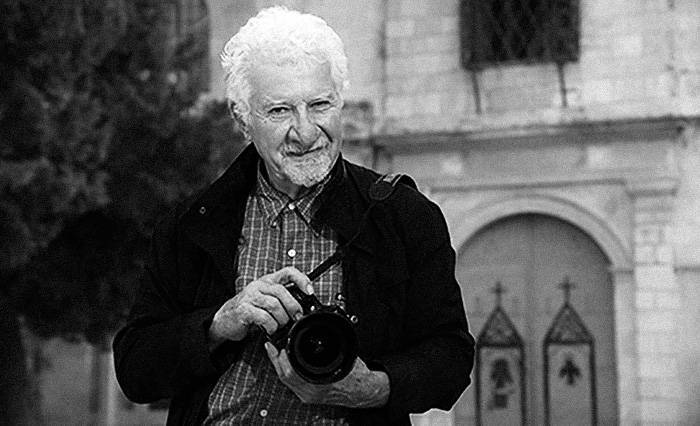
Garo Nalbandian
Garo discloses to Raseef22 that he identifies as a Palestinian Armenian and refuses to receive an Israeli nationality. He also identifies as a ‘Palestinian refugee’, after his parents were displaced by Armenian massacres. He adds, “I was one of the first photographers that published photos to the world of events taking place in Palestine and Jerusalem specifically.”
Despite being Christian, Garo is the photographer most preferred by the Jerusalem Islamic Waqf organization to take photos of the Aqsa Mosque, citing his high moral and professional integrity.
“They are also considered the godfathers of the art of inscribed pottery and ceramics, a craft they reintroduced to the city following many years of absence. Considered one of their most significant accomplishments in Palestine, Armenian ceramics connect the entrance of the neighborhood to the al-Aqsa Mosque, surrounding the minarets of the mosque as well as the Dome of the Rock itself.”
The Palestinian photographer firmly believes that Israel has repeatedly tried to create a rift between Armenians and Palestinians, making it easy for them to acquire the Israeli nationality, yet most refused. He affirmed, “The Israeli nationality may have made my life much easier, but I firmly refused. I will always introduce myself as a Palestinian Armenian refugee.”
Garo recounts that he suffered during his childhood, having been forced to leave school and work at the age of 9, as did many other Armenian children of the same age. He believes these difficult conditions pushed some Armenians to excel and lead in a number of fields.
Garo joining the world of photography was no coincidence, since according to him, Armenians were the first to introduce the practice into Jerusalem, even before the Israelis did. In fact, it was the Armenian Patriarch in Jerusalem, Yessayi Garabedian, who learned the art of photography in Istanbul and later in London and Paris, eventually introducing it to the Old City in the late 50s of the 19th century.
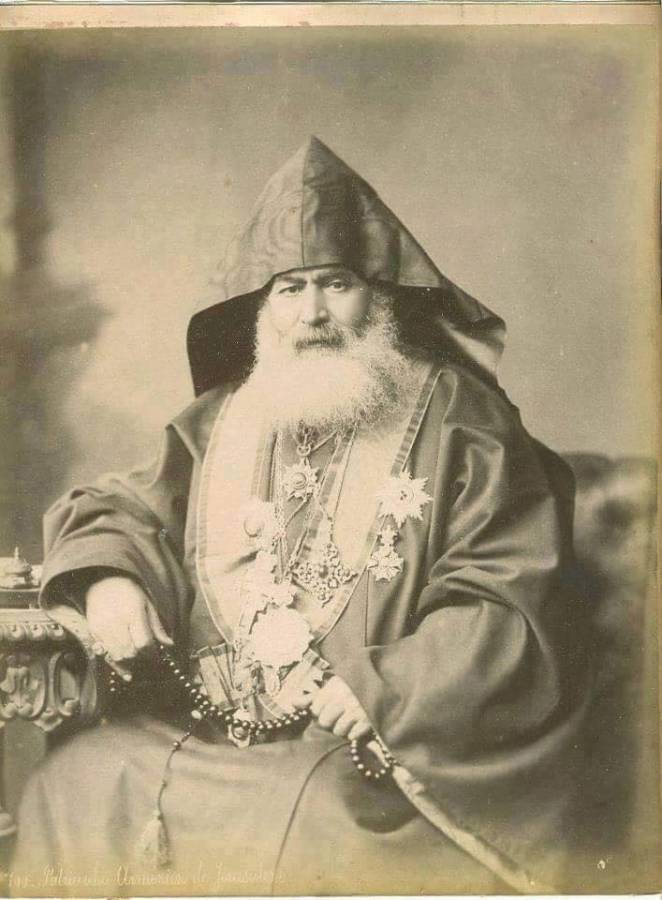
Yessayi Garabedian
Armenians were the first to introduce photography into Jerusalem, even before the Israelis did. In fact, it was the Armenian Patriarch in Jerusalem, Yessayi Garabedian, who learned the art of photography in Istanbul and later in London and Paris, eventually introducing it to the Old City in the late 50s of the 19th century.
Armenians in Memoriam
Historian Ibrahim Banalian carries on the account of the legacy of his Armenian ancestors. He created a Facebook page under the name “Apo Documentaries", where he posts old photos of the city of Jerusalem throughout the ages, including the ages of the British Mandate and Ottoman rule.
Banalian aims to educate the new generations in Jerusalem of the recent history of their city through his page by integrating images with text. He points out that many of these photos were taken by Armenians, since dozens of photographers were known during those periods to be of Armenian descent.
“Even though Armenian presence in Jerusalem is almost over, the diverse and rich history of the Armenian community is worthy of consideration and can never be erased from the city’s memory.”
The article “Armenian Pages in The History of Jerusalem” cites Jordanian military commander Abdullah al-Tal stating in his journal that Armenians saw themselves as Arabs during the 1948 war in Palestine, where they “drank from the same cup as Palestinian” did, until they lost at least 8 martyrs in Jerusalem and Jaffa. The migration of thousands of Armenians from the city of Jerusalem during the 1948 war was not the final exodus. It was repeated during the 1967 war when Armenian families were forced into displacement once again, leaving behind homes in the Armenian Quarter in Jerusalem’s Old City which Israeli authorities then gave to settlers.
The presence of Armenians throughout the years in Palestine generally, and Jerusalem specifically, indicates the rich historic diversity of the city; at the same time denouncing Zionist claims that Jerusalem is the “city for Jews” alone.
Even though Armenian presence in Jerusalem is almost over, the diverse and rich history of the Armenian community is worthy of consideration and can never be erased from the city’s memory.
Raseef22 is a not for profit entity. Our focus is on quality journalism. Every contribution to the NasRaseef membership goes directly towards journalism production. We stand independent, not accepting corporate sponsorships, sponsored content or political funding.
Support our mission to keep Raseef22 available to all readers by clicking here!
Interested in writing with us? Check our pitch process here!
